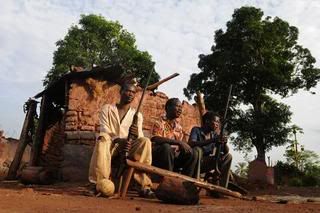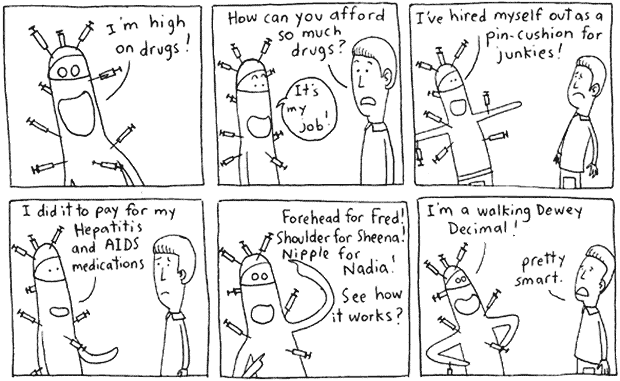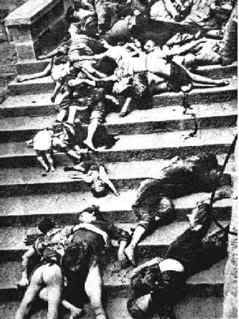When one first looks at the photo, the woman immediately stands out, which plays an important role in the argument of the image. A powerful element that contributes to this focal point is the way in which the image is framed and cropped. By isolating the receding room, the wall, and the woman as the only elements in the picture, the photo presents a clear
visual hierarchy. Thus, via logos, the image is better able to “shap[e] someone else’s attention,” meaning the viewer’s (Compose, Design, Advocate, 285). In other words, restricting the number of elements within the frame directs the reader’s attention to specific aspects of the photo. The pinnacle of this hierarchy includes the woman, as she is the closest in the foreground. This is important, as the viewer is then drawn to inspect her gestures more carefully to find a meaning to them.
In addition to framing, the alignment of these key elements also shapes how the reader perceives the photo. Due to the orthogonal orientation of the wall and background in respect to the frame, the audience uses the grid-like structure to inspect all parts of the photo. Eventually, however, the viewer’s eye comes to rest on the woman and what she represents. The juxtaposition of this rigid framework with the more dynamic pose of the woman reinforces the notion that she is the focal point of the image. Nevertheless, the audience’s inspection of this alignment in respect to the woman is also important, as it provides a backdrop or setting for her, upon which the viewer can expand.

Besides the framing and alignment of the photo, the coloration is another key element that relates to the argument of the image. In looking at the photo, there are generally two categories of color that are used. The receding room and wall are both dark hues: black and brown. The woman, however, is wearing a white top and blue jeans, which are much brighter hues. This difference in coloration creates high contrast between the woman and her background, reinforcing the notion that she is at the peak of the hierarchy. Furthermore, these hues enforce the narrative of the photo, as the dark hues from the shadows are logically associated with the negative experiences from her past (rape). There is also a bright, white light piercing from a window through the dark room, which logically represents a shining hope throughout her past. She has come out of this past, however, to stand exposed against the wall, only to be haunted by remaining shadows. This narrative, supported by the alignment and hues, also reinforces the woman as the primary element of the photo.
As the image uses appeals to logos via framing and coloration to direct the attention of the audience toward the woman, she is presented as the primary vector of attention within the photo. Positioned as such, further examination of her gestures reveals that her left hand is covering her eyes, hiding them from the camera lens, and in turn, the eyes of the audience. Due to this inability to establish eye contact with her, the audience is distanced somewhat from her specific situation. As onlookers, the issue then becomes the reason for her masked face. Logically, one looks to her body language for further explanation. However, in addition to logos,
Compose, Design, Advocate says that this body language also appeals to pathos. As stated on page 352, “Vectors of attention are thus about…emotional connections within the photograph as well as between the photograph and the audience.” In this manner, the viewer can then look to her gestures for answers about her emotional state.
Looking at the woman, there is the insinuation of a lack of confidence, as she is seen covering her eyes, looking downward, and turning away from the camera. Further on in
Compose, Design, Advocate, the author mentions “obvious pathos.” He says, “When we see people in a photograph, we might identify with them: we understand the situation they are in through our own experiences” (274). Indeed it is unlikely that many members of the audience have first-hand experience with rape. Despite this, most have probably experienced embarrassment, shame, or emotional instability at one time or another, which are the emotions portrayed by the woman. These feelings, consequently, are also an effect of rape, leading to a common connection between the audience and the woman (
RAINN). The result of this is that as onlookers, the audience becomes sympathetic toward the raping of the woman, as well as her mental condition. This is especially true from a Western standpoint, which emphasizes values such as "liberty and justice for all" (The Pledge of Allegiance). On a different level, someone from the Congo, who has personal experience with similar situations, might react with rage directed toward the army. They too, however, would probably be sympathetic toward the woman, with both cultures agreeing that something needs to be done to stop these acts of rape from happening.

Through the use of isolation framing and contrasting coloration to highlight the woman as a vector of attention, the photo
Very Bad by Anna Kari supports the argument through pathos and logos that assistance and support is needed in this region. With the history of rape as seen through incidences such as the Rape of Nanking, as well as the current published articles of the Congo, this image provokes a feeling of sympathy as pertaining to its audience. Rape can be life-altering, as it is emotionally, socially, and mentally taxing (RAINN). Looking at this situation from a Western perspective, then, the issue goes beyond sympathy. What can be done to assist these victims of rape? Surely such exploitation is inhumane and intolerable, but how is one to go about ending this crisis? Although the problem lies in the armed forces that patrol the region, in some cases it involves the same national army that is supposed to be protecting citizens. In looking at the photo, maybe it provides not only insight into such a problem, but to the solution as well. Perhaps the first step toward a better tomorrow is to unite the women of the Congo, showing their faces to the world.




